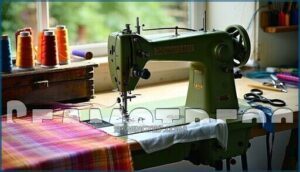This site is supported by our readers. We may earn a commission, at no cost to you, if you purchase through links.

Sewing skills open doors to careers like seamstress, tailor, garment worker, or fashion designer.
You could work in textile manufacturing as a production worker or material handler.
The fashion world needs retail merchandisers and stylists too.
Home-based tailoring lets you be your own boss, fixing hems and altering clothes for neighbors.
You’ll need solid sewing skills, attention to detail, and good communication abilities.
Some jobs require formal training, while others welcome self-taught sewers.
The textile industry is always evolving, creating fresh opportunities you might not expect, with new roles like fashion designer and garment worker.
Table Of Contents
Key Takeaways
- You’ll find diverse sewing career paths from hands-on roles like seamstress and tailor to business positions like textile buyer and logistics manager, with salaries ranging from $25,000 to $60,000+ annually.
- You can enter the field through apprenticeships with experienced craftspeople or direct applications to companies that value hands-on skills over formal degrees, making it accessible to self-taught sewers.
- Home-based sewing businesses offer flexibility and independence through custom tailoring, alterations, and repairs, letting you build your own client base as your own boss.
- Success requires both technical sewing abilities and strong communication skills to understand client needs and build lasting professional relationships.
Textile Industry Jobs
You’ll find textile industry jobs span from hands-on production work to behind-the-scenes logistics roles. These positions keep the massive textile manufacturing process running smoothly, from raw materials to finished products.
Material Handler
As a material handler in textile production, you’ll earn around $17-22 hourly managing the backbone of apparel manufacturing. This role keeps fabric flowing smoothly through supply chain operations.
Keep fabric flowing smoothly through supply chain operations as the backbone of apparel manufacturing.
Your key responsibilities include:
- Operating forklifts and warehouse equipment safely
- Managing inventory systems with precise tracking
- Inspecting materials for quality control standards
- Coordinating transfers between storage and production lines
- Following safety protocols in fast-paced environments
You’ll need physical stamina and attention to detail. Most textile workers get on-the-job training, making this an accessible entry point into the industry with a chance to work in fast-paced environments.
Production Worker
As a textile production worker, you’ll run sewing machines on assembly lines making garments and fabric products.
You handle pattern matching, quality control checks, and follow workplace safety rules.
This textile worker role in apparel manufacturing pays around $35,000 yearly.
Sewing machine operators need steady hands and attention to detail for fabric work, and many seek specialized equipment options to improve efficiency.
Buyer
While production workers handle the hands-on manufacturing, buyers shape what gets made through smart fabric sourcing and trend analysis.
You’ll scout suppliers worldwide, securing quality textiles at competitive prices through cost negotiation skills.
Your daily work involves:
- Analyzing fashion industry data to predict upcoming trends
- Building strong vendor relations with textile suppliers
- Conducting quality control assessments on fabric samples
- Managing procurement budgets averaging $500,000 to $5 million annually
This sewing job requires sharp analytical skills and market awareness. You’re basically the bridge between fashion design concepts and actual garment making.
The job market shows strong demand, with buyer positions growing 14% since 2023. Your decisions directly impact production success and company profits.
Logistics Manager
In today’s fast-paced textile world, you’ll orchestrate the entire supply chain from raw materials to finished products.
Your role centers on inventory control, ensuring adequate stock levels while minimizing carrying costs.
You’ll develop distribution strategies that streamline product flow from factories to retailers.
Managing warehouse operations becomes your daily focus.
You’ll coordinate with suppliers, negotiate transportation costs, and oversee shipping schedules.
Your analytical skills help identify bottlenecks and implement solutions that boost efficiency.
This sewing career demands strong problem-solving abilities.
You’ll use data analytics to forecast demand and optimize inventory levels.
Working with cross-functional teams, you’ll align production schedules with market needs.
The sewing job market values logistics managers who understand both traditional methods and emerging technologies.
You’ll implement automated systems and track key performance metrics.
Your expertise in warehouse management and cost control directly impacts company profitability.
Success in sewing jobs requires balancing customer satisfaction with operational efficiency.
You’ll troubleshoot delivery issues and continuously improve processes across the entire textile supply chain.
Strong candidates often have experience in transportation coordination.
Researcher
Textile researchers enter the sewing job market by developing innovative fabric solutions and analyzing industry trends.
This sewing profession offers strong career opportunities with competitive salary analysis.
- Research Methods – Design experiments to test new textile properties
- Data Analysis – Examine fabric performance and market statistics
- Sample Collection – Gather materials from manufacturers and suppliers
- Literature Review – Study published findings on textile innovations
You’ll spend your days in labs, running tests on everything from thread strength to color durability.
Report Writing becomes second nature as you document discoveries that could revolutionize how we approach sewing and textile production.
Fashion Industry Jobs
Fashion jobs offer creative outlets beyond traditional design roles. You’ll find sewing skills valued in retail merchandising, sales positions, and styling work where fabric knowledge makes you stand out.
Retail Merchandiser
You’ll find retail merchandising offers steady sewing compensation beyond the factory floor.
Your role involves creating Visual Displays that showcase garments effectively.
You’ll handle Inventory Management, tracking which pieces sell fastest.
Trend Analysis helps predict what customers want next season.
Focus on Customer Experience by arranging clothing logically.
Develop Sales Strategies that highlight your sewing profession knowledge.
This career path combines creative visual skills with business sense, offering competitive sewing salary potential.
Retail Sales Associate
While merchandising creates the stage, retail sales associates become the stars who bring fashion to life.
Your sewing background gives you deep product knowledge that customers trust.
You’ll earn around $52 per transaction by mastering these core skills:
- Customer Service – Build relationships through genuine fashion expertise and personalized recommendations
- Sales Techniques – Use upselling and cross-selling to boost your daily $1,250 quota naturally
- Visual Merchandising – Apply your eye for detail to create displays that sell themselves
- Inventory Management – Handle restocking up to 30 times daily while tracking popular items
Your sewing experience translates perfectly into understanding fabric quality, fit, and construction details that impress customers.
This job search advantage opens career opportunities in specialty stores where technical knowledge matters most.
Stylist
Beyond retail sales, you can shape looks as a stylist. You’ll work with clients through image consulting and personal shopping services. Your fashion trends knowledge helps create complete wardrobe planning solutions.
As a stylist, you transform how clients present themselves. You select clothing and accessories that match their lifestyle. Strong client relations skills help you understand their needs. You guide them toward confidence through better style choices.
| Service Type | Client Need | Your Solution |
|---|---|---|
| Image Consulting | Professional appearance | Corporate wardrobe |
| Personal Shopping | Time constraints | Curated selections |
| Wardrobe Planning | Style confusion | Organized closets |
Many stylists start with seamstress work or tailoring career experience. This background in fabric artist skills helps you understand garment fit. Some expand into costume design or maintain dressmaker occupation skills. Understanding visual merchandising trends is also beneficial for stylists. Your fashion expertise becomes the foundation for building lasting client relationships through personal shopping and wardrobe planning.
Home Sewing Jobs
Working from home gives you the flexibility to turn your sewing skills into steady income through custom alterations and repairs.
You can build a client base by offering tailoring services for wedding dresses, business suits, and everyday clothing that needs adjustments.
Tailor
As a tailor, you’ll master custom tailoring and alteration services for discerning clients.
Your measuring techniques and fitting process skills transform fabric into perfectly fitted garments. This tailoring career demands precision in fabric selection and clothing alteration.
You’ll work closely with customers, ensuring each piece reflects their style while showcasing your expertise as a fabric artist in the dressmaker occupation.
Many tailors also function as alterations specialists, providing garment fitting and custom adjustments.
Seamstress
You’re skilled at custom clothing creation and alteration expertise.
As a seamstress, you’ll use sewing machines daily while developing textile knowledge through hands-on experience.
Your stitching professional skills grow as you master embroidery specialist techniques and pattern maker abilities.
Clothing alteration requests keep you busy, from hemming pants to redesigning wedding dresses.
Needlework expert status comes with practice and dedication to your craft.
To excel, you’ll need deep knowledge of fabrics and textile types, including understanding various deep knowledge of fabrics to become a skilled seamstress with textile expertise.
Job Requirements
Before you start your sewing career, you’ll need specific skills that employers look for. Strong sewing abilities and clear communication skills are the foundation for success in any sewing job.
Sewing Skills
Your success in sewing careers depends on technical skills and attention to detail. Whether you’re aiming to become an embroidery specialist or pattern maker, mastering these fundamentals will boost your sewing income potential.
Strong stitching professionals need these core abilities:
- Stitch Types – Master straight, zigzag, overlock, and specialty stitches
- Pattern Making – Read blueprints and create custom templates accurately
- Fabric Selection – Know how cotton, silk, denim, and synthetics behave
- Machine Maintenance – Keep equipment running smoothly and troubleshoot issues
Design principles matter too. You’ll need steady hands for precise seams and the patience to fix mistakes. A needlework expert understands that rushing leads to poor results.
To guarantee proper layering, remember to iron fabric beforehand. Think of sewing skills like building muscle memory. Each project strengthens your abilities. Start with simple techniques and gradually tackle complex work. Your fingers will learn to feel fabric tension naturally. Soon you’ll spot problems before they become costly errors.
Communication Skills
When working in any craftsperson role, you’ll need strong communication skills to thrive.
Active listening helps you understand client needs clearly. Clear articulation guarantees your ideas come across without confusion.
Written communication matters for emails and project notes. Pay attention to nonverbal cues from customers and colleagues.
Conflict resolution skills keep workplace tensions low. These interpersonal skills directly impact your sewing income in skill-based jobs.
Good communicators build trust, earn repeat clients, and create positive work environments that boost career success. They also help to maintain a healthy and productive workplace by utilizing effective conflict resolution techniques and clear articulation of ideas.
Getting Started
You can break into sewing careers through apprenticeships with experienced tailors or by applying directly to textile and fashion companies.
Many employers value hands-on skills over formal degrees, so building a strong portfolio of your work often matters more than classroom credentials, with hands-on skills being particularly valued.
This approach allows individuals to demonstrate their capabilities and strong portfolio in a practical manner.
Apprenticeship
Mentorship-guided learning opens doors to textile mastery you can’t get from books alone.
Hands-on experience with master craftspeople beats any classroom theory every time.
Sewing apprenticeships connect you with seasoned craftsperson role models who’ll teach everything from basic stitches to complex pattern work.
These skill-based jobs offer structured program structure where you’ll earn while learning essential techniques.
- Shadow experienced sewers to gain hands-on experience
- Start with basic hand-sewing techniques before moving to machines
- Learn about fabrics, patterns, cutting, and finishing
- Build a portfolio of custom sewing projects
- Gain insights into running a small sewing business
Real apprenticeships provide onthejob learning that builds confidence fast.
The sewing industry offers diverse career paths.
Industry demand for skilled workers makes these programs valuable investments.
Your earning potential grows as skill development progresses through structured job training phases.
Direct Application
You can skip apprenticeships and jump straight into sewing careers through direct application. Many companies hire beginners willing to learn on the job.
Start with your online application – most employers prefer digital submissions over paper submission. Gather required materials like your resume and references beforehand.
Don’t hesitate to use contact assistance if you need help with the process. Some companies offer appointment setup for interviews.
Focus on upholstery sewing or general production roles that offer competitive sewing wages. These skillbased jobs value dedication over extensive experience, making sewing earnings accessible to newcomers.
To get started, explore options for sewing-related products.
Current Job Openings
Today’s sewing job market offers more employment opportunities than ever before.
The textile industry’s growth has created diverse job openings across multiple sectors.
You’ll find positions ranging from entry-level production roles to specialized technical positions with competitive salary ranges.
Current job search strategies should focus on these key areas:
- Local manufacturing facilities – Many offer part-time options with flexible schedules
- Fashion retailers – Seasonal hiring often includes attractive hiring incentives
- Alteration shops – High demand creates steady work opportunities
- Home textile companies – Growing market with extensive benefit packages
- Custom design studios – Creative roles with competitive compensation
Application deadlines vary by employer, but many positions remain open until filled.
Local job listings show consistent demand for skilled sewers.
Manufacturing roles typically offer the most stable employment with full benefits.
Retail positions provide flexibility but may have seasonal fluctuations.
Don’t overlook smaller operations – they often provide the best learning experiences and career advancement opportunities.
Frequently Asked Questions (FAQs)
What kind of work includes sewing?
You’ll find sewing in fashion design, tailoring, upholstery, costume creation, alterations, textile manufacturing, quilting, and crafting. These roles need precision with fabrics, patterns, and stitching techniques for various products.
What is the classification of sewing?
Like ancient spinners at their wheels, you’ll find sewing classified as a skilled trade within manufacturing, textiles, and crafts industries.
It’s technical handiwork requiring precision, patience, and expertise in fabric manipulation techniques.
What jobs can you do with sewing skills?
You can become a fashion designer, tailor, costume designer, or alterations specialist. Consider upholsterer, quilter, textile artist, or seamstress roles. Manufacturing jobs include production sewing or quality control positions.
What sewing machines work best for beginners?
Practice makes perfect when choosing your first sewing machine.
Start with basic mechanical models like Brother XM2701 or Singer Start
They’re reliable, affordable, and won’t overwhelm you with fancy features you don’t need yet.
How much do professional sewers typically earn?
Professional sewers’ earnings vary widely based on experience and location.
You’ll find entry-level positions starting around $25,000 annually, while skilled seamstresses earn $40,000-60,
Freelance tailors can make even more with established clientele.
What education is needed for sewing careers?
Think sewing careers only need nimble fingers? You’ll need formal training too.
Most employers want vocational certificates, associate degrees, or apprenticeships.
Fashion design requires bachelor’s degrees.
You’ll master pattern-making, industrial machines, and quality control techniques.
Which sewing certifications boost employment opportunities?
You’ll want to pursue certifications like the Certified Fashion Designer (CFD), Pattern Making Certification, or Industrial Sewing Machine Operator credentials.
These specialized certifications demonstrate your technical skills to employers and substantially improve your job prospects.
How long does sewing skill development take?
You’ll need roughly six months to two years developing solid sewing skills, depending on your dedication and practice frequency.
Basics come quickly, but mastering advanced techniques takes consistent effort and patience.
Conclusion
Threading your way through career possibilities, sewing skills open doors you didn’t know existed.
Whether you’re asking "what job is sewing," the answer spans from factory floors to fashion runways.
You can start as a production worker, climb to buyer roles, or launch your home tailoring business.
Each path needs different skills and training levels.
The textile world keeps growing, creating fresh opportunities for skilled sewers ready to stitch together their future careers.
- https://en.wikipedia.org/wiki/List_of_sewing_occupations
- https://www.mightyrecruiter.com/job-descriptions/sewing-machine-operator/
- https://hrblade.com/job-descriptions/sewing
- https://www.ziprecruiter.com/e/What-are-the-key-skills-and-qualifications-needed-to-thrive-in-the-Sewing-position-and-why-are-they-important
- https://www.reddit.com/r/sewing/comments/811hcp/to_anyone_whos_taken_a_sewing_test_for_a_job_what/














